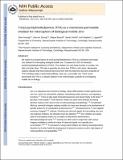| dc.contributor.author | Huang, Zhen | |
| dc.contributor.author | Zhang, Xiao-an | |
| dc.contributor.author | Bosch, Miquel | |
| dc.contributor.author | Smith, Sarah J. | |
| dc.contributor.author | Lippard, Stephen J. | |
| dc.date.accessioned | 2015-02-24T20:11:52Z | |
| dc.date.available | 2015-02-24T20:11:52Z | |
| dc.date.issued | 2013-05 | |
| dc.date.submitted | 2013-03 | |
| dc.identifier.issn | 1756-5901 | |
| dc.identifier.issn | 1756-591X | |
| dc.identifier.uri | http://hdl.handle.net/1721.1/95490 | |
| dc.description.abstract | We report the characterization of tris(2-pyridylmethyl)amine (TPA) as a membrane-permeable zinc chelator for intercepting biological mobile zinc. Compared to N,N,N′,N′-tetrakis(2-pyridylmethyl)ethylenediamine (TPEN), TPA chelates zinc with faster kinetics in cuvettes, live cells, and brain slices. TPA also is generally less toxic than TPEN in cell culture. Mechanistic analysis indicates that these improvements arise from both the electronic and steric properties of TPA including weaker metal-binding affinity, lower pK[subscript a], and smaller size. These results demonstrate that TPA chelation is a valuable addition to the methodologies available for investigating mobile zinc in biology. | en_US |
| dc.description.sponsorship | National Institute of General Medical Sciences (U.S.) (Grant GM065519) | en_US |
| dc.description.sponsorship | FRAXA Research Foundation (Fellowship) | en_US |
| dc.language.iso | en_US | |
| dc.publisher | Royal Society of Chemistry, The | en_US |
| dc.relation.isversionof | http://dx.doi.org/10.1039/c3mt00103b | en_US |
| dc.rights | Creative Commons Attribution-Noncommercial-Share Alike | en_US |
| dc.rights.uri | http://creativecommons.org/licenses/by-nc-sa/4.0/ | en_US |
| dc.source | PMC | en_US |
| dc.title | Tris(2-pyridylmethyl)amine (TPA) as a membrane-permeable chelator for interception of biological mobile zinc | en_US |
| dc.type | Article | en_US |
| dc.identifier.citation | Huang, Zhen, Xiao-an Zhang, Miquel Bosch, Sarah J. Smith, and Stephen J. Lippard. “Tris(2-Pyridylmethyl)amine (TPA) as a Membrane-Permeable Chelator for Interception of Biological Mobile Zinc.” Metallomics 5, no. 6 (2013): 648. | en_US |
| dc.contributor.department | Massachusetts Institute of Technology. Department of Brain and Cognitive Sciences | en_US |
| dc.contributor.department | Massachusetts Institute of Technology. Department of Chemistry | en_US |
| dc.contributor.department | Picower Institute for Learning and Memory | en_US |
| dc.contributor.mitauthor | Huang, Zhen | en_US |
| dc.contributor.mitauthor | Zhang, Xiao-an | en_US |
| dc.contributor.mitauthor | Bosch, Miquel | en_US |
| dc.contributor.mitauthor | Lippard, Stephen J. | en_US |
| dc.contributor.mitauthor | Smith, Sarah J. | en_US |
| dc.relation.journal | Metallomics | en_US |
| dc.eprint.version | Author's final manuscript | en_US |
| dc.type.uri | http://purl.org/eprint/type/JournalArticle | en_US |
| eprint.status | http://purl.org/eprint/status/PeerReviewed | en_US |
| dspace.orderedauthors | Huang, Zhen; Zhang, Xiao-an; Bosch, Miquel; Smith, Sarah J.; Lippard, Stephen J. | en_US |
| dc.identifier.orcid | https://orcid.org/0000-0002-2693-4982 | |
| mit.license | OPEN_ACCESS_POLICY | en_US |
| mit.metadata.status | Complete | |
